Legends & Tales
Legends and myths - fantastic tales that make many places interesting. Passed down orally from generation to generation, they do contain a grain of truth as well as a moral, but the majority of the content of each tale has been embellished and reshaped over the years. There are also numerous legends and myths surrounding the eleven villages in the Reutte Nature Park region. With the kind support of Peter Linser, author of the popular book "Sagenhaftes Außerfern", as well as the cultural guide Alexandra Posch, we have collected some tales of our region here. The illustrations are by Brigitte Köck from Häselgehr. We hope you enjoy browsing through them!
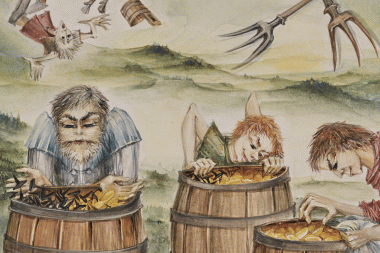
Ghost spell in the Stuibenfall
If an unredeemed soul was to be banished somewhere, usually with spiritual assistance, it was banished to a secluded area for eternity.
A preferred place of banishment for Reutte and its surroundings were the "Stuibenfälle". At that time, the spirit "Hans Bumm" - trapped in a bottle or can - was carried there to the sound of drums and whistles. The "Plumpergeist" went into the trap in a smock sleeve and was brought here in it. It was strange that with the cessation of the music also the spirit could not be brought any further. At night, according to their credible testimony, two sisters living near the Stuibenfall saw several bright little lights dancing around in the water dew of the roaring and foaming Archbach.
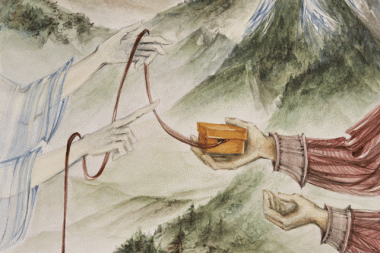
The Saligen Fräulein at the Gachtberg
Next to the road between Höfen and Weißenbach rise the steep crags of the Gachtberg. In the past, Salige Fräulein used to stay in the crevices and caves and the supposed location of their castle is still called the "Hexenplätzle" today. Often the Fräulein were seen cooking, but they were also observed dancing to beautiful music and lovely singing. Not infrequently they visited the shepherds without bad intentions, they were generally well-disposed towards the people.
About its origin the following is told:
Many hundreds of years ago, a foreign officer was quartered in the Kreckelmoos building for a long time. When he left, he left three sealed barrels with the innkeeper, asking him to send them to a certain address if he did not return within a year. The year passed without the stranger's return and the barrels were also forgotten.
After a long time, the people of Kreckelmoos started to open them. On the top they found only shoe nails, but further down they found gold pieces, which the curious farmers appropriated. Having become rich, they bought many fields and plots of land, built trading houses, and finally even had their own ships floating on the sea. But the dishonestly acquired property brought no luck.
As soon as the first Kreckelmooser died, he had to ghost as punishment. This fate was shared by all his successors, until finally the last scion of his family died impoverished as a child. At his death there was a terrible noise and a "six-horse carriage" drove around the house all night. Later, the spirit was banished to the nearby Stuiben Falls, accompanied by music.
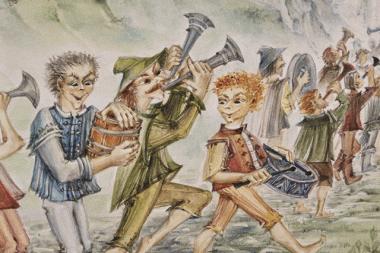
Geisterbann im Stuibenfall
Wenn irgendwo, meist mit geistlichem Beistand, eine unerlöste Seele vertrieben werden sollte, wurde sie für weltewige Zeiten in eine abgeschiedene Gegend verbannt.
Ein bevorzugter Verbannungsort für Reutte und seine Umgebung waren die „Stuibenfälle“. So trug man seinerzeit den Geist „Hans Bumm“ – gefangen in einer Flasche bzw. Dose – unter Trommelklang und Pfeifenspiel dorthin. Der „Plumpergeist“ ging in einem Kittelärmel in die Falle und wurde darin hierher verbracht. Dabei war merkwürdig, dass mit dem Aussetzen der Musik auch der Geist nicht mehr weiter gebracht werden konnte. Bei Nacht sahen nach ihrer glaubwürdigen Aussage zwei nahe dem Stuibenfall wohnende Schwestern im Wasserstaube des tosenden und schäumenden Archbaches mehrere helle Lichtlein herumtanzen.
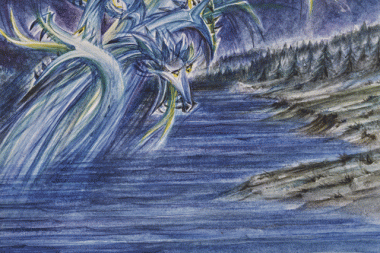
The dragon in the lake of uri
Just above Mühl, on a spur of the Dürrenberg, lies the small but deep Urisee. On the other side of the valley, on a promontory of the Gehrenspitze, stretches the quiet Frauensee. In its depths, the Urisee harbors a hideous dragon, which sometimes rushes over to the Frauensee at night in a fiery flight of sparks. Some claim that the beast has seven heads and sometimes basks on the sunny shore. Others want to have already seen that the dragon looks like a "maltreated steed".
It is said that in the past there was a well-functioning blacksmith's shop on the site of Lake Uri. Unfortunately, the wife of the master was a snake and godforsaken. So it is said that once when her son fell into the street dirt, she cleaned and dried him with freshly baked white bread instead of a cloth or sponge. This angered the heavens so much that the forge sank and the lake was formed. The woman was transformed into a fire dragon, which now suffers punishment and torment in the water. Some also believe that if the water of the lake is low, it means a fruitful year.
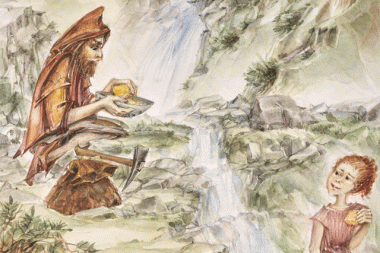
Goldbrünnele and Venedigermännle
On the Raazalpe in the Rotlechtal there is a spring from which pure gold flows at a very specific moment and whoever knew this moment would be rich at a stroke. Often Venetian men came there and fetched gold, because they knew exactly the place and the right moment. So it happened once that at this particular time a maid came from the alpine hut to the fountain to fetch water. From a distance, she saw a little man with a wide-brimmed hat busily working at the spring; the little fellow, barely as tall as a table, was drawing water from the well with a small vessel. The dairymaid was afraid of the strange stranger and did not dare to go any further.
Since she was not allowed to return to the hut without water, she took heart and went closer. The little man was not frightened, nor was he angry, he spoke to her in a friendly manner and even asked her if she would like some of what he had just scooped out. The girl immediately answered in the affirmative, as she urgently needed to bring home some water. To her astonishment, the Venetian gave her a lump. She returned to the hut without protest. It turned out that the lump was pure gold and the maid had to tell everything.
The peasant, in his discontent, drove her wildly and shouted angrily, "You stupid thing! Why didn't you let me give you more of it? In a moment you'll go out and get more!" As quickly as the girl ran back to the fountain, the little man had disappeared. The water bubbled as always and nowhere was there a trace of gold to be seen.
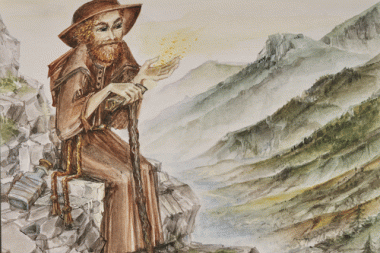
The Mangsessele
When St. Magnus came to Reutte to preach Christianity to the people, he stopped for a rest near Oberletzen. Tired, he sat down on a large stone. There, where he had sat down, you can still see a depression today. It has the shape of an armchair. People therefore call this place the "Mangsessele" or also "Sankt Mang Sessele".
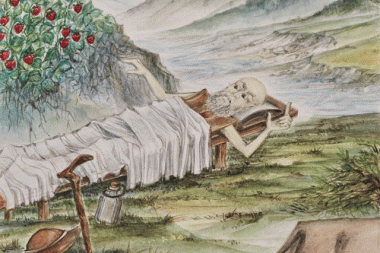
Blessed Brother Ulrich
In 1380 the pious hermit Ulrich died in Musau. In an allegedly Latin document in Füssen it says: "In the Hoheneck shelter district of Musau, Brother Ulrich, who came as a pilgrim, settled down, lived in quiet solitude and devoted himself to the works of Christian charity. He was a benefactor and messenger of peace to the area, he was (as it says in the chronicle of Father Plazidus Keller) a penitent knight." From his life and his quiet surroundings there are only very few remains: a stick made of blackthorn with an iron tip and a wooden water bottle. Earlier there were also his hat as well as the bedstead in which he died....
Once, when this pious hermit was lying on his deathbed, it was deep winter, he felt like eating strawberries. When those present refused this unseemly desire, he rebuked them for their petty faith and sent them to the nearest hill. Indeed, there, in the midst of the ice and snow, they found fresh strawberries. Even today that elevation is called "Beerbichl" because of this wish.
Death approached and Brother Ulrich communicated his last wish: Let his body be placed on a cart, hitched to it by two untrained young bulls, and buried where they dragged him. When he died, they put the body on a cart and first harnessed two tame oxen to it, which had pulled it many times before. Only when these could not bring the vehicle from the place, one harnessed young bulls. To everyone's amazement, they pulled the wagon through the Lech and up the hill where today's Pinswang church stands. There they remained rooted to the spot and could not be moved. They took the dead man from the wagon and began to dig a grave. Then they came to a large stone, under which there was a pit as long as a man. Blessed Ulrich was buried in it.
The guard of the Kniepaßschanze always saw two little lights burning at this grave during the night. This is said to have been the reason for building the deceased his own tomb, where he is still said to rest today. It is also said that two candle lights were often seen burning in this burial chamber. The people eagerly visited his tomb. In the course of time, several miracles and the strangest things happened there. A chapel was built and soon enlarged because of the great crowds. Today, the sacred beauty of the Baroque parish church of Pinswang pleasantly dominates the scenic landscape.
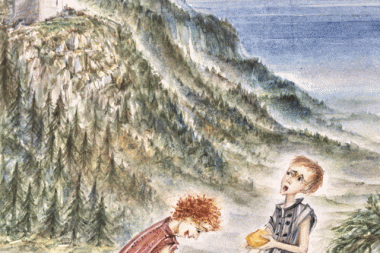
The golden horse studs
Where once stood the proud Vilseck Castle, only dilapidated walls still bear witness to its former glory.
Overgrown bushes grow in the courtyards and ravens sit in the rotten window reveals. Once a few children were playing in the ruins. There they found fresh horse dung in a remote vault, which lay in a place where no steed can ever reach. This seemed strange to the astonished children. Some of them therefore took some horse dung with them. At home they showed their strange find and lo and behold - the horse clods had turned into pure gold. They quickly ran back to Vilseck to get the rest. But they didn't find another speck.
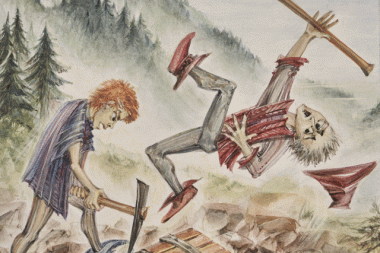
The treasure in Windegg Castle
Somewhere between Wängle and Lechaschau, a castle is said to have stood in times long past. When and why "Windegg" disappeared, no one can say today. For a long time, it was believed that a rich treasure lay in the earth in its place. Many attempts were made in vain to unravel the mystery and to find the treasure.
Once two brave men decided to try again. They dug in the stony earth for a long time until they finally encountered resistance at a depth of eight to nine feet. Eagerly they continued digging until at last an iron-bound chest appeared. Carefully they shoveled the container free and were about to lift the treasure. Then one of them, happy at the find, rejoiced with the words, "Now hammer it!" At that moment he staggered to the ground as if an invisible hand had slapped him in the face; the box began to rumble and rumble - unopened, it sank into the earth forever. The treasure digger, however, was left with a "crooked mouth" from the slap for the rest of his life.of Pinswang pleasant scenery.
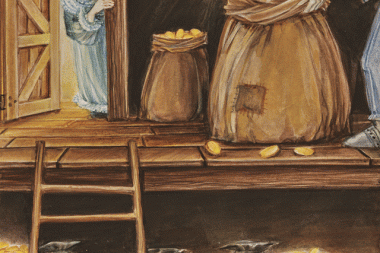
The magician in the plate mill
In the past, a new grinder was hired at the Plattenmühle near Höfen. Soon it was rumored that he was in contact with evil forces and that with their help he was able to perform all kinds of magic. Once upon a time, on Christmas Eve, the millwoman, who was very attentive to light, heard the grinder working. Immediately the good woman woke up her husband and told him to go and have a look. He could not believe his eyes: the mill was in full swing.
The grinder was working like a man possessed. But what was being ground was not grain, but pure gold. Instead of flour, heaps of flashing gold coins appeared. With these the servant filled one sack after the other. With open mouth and shining eyes, the astonished miller counted the magnificent sacks - twenty-four were already filled to the top. The righteous man, however, was so horrified by this that he immediately chased the sinister servant away with all his devil's money.
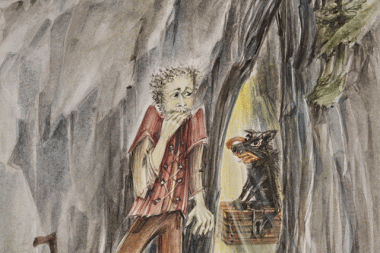
The castle ghost
In Ehenbichl, a ghost in the shape of a poodle used to frighten people. Sometimes he was red, sometimes black and had fiery eyes almost as big as a mill wheel. Once he stole a side of bacon from the smokehouse of Riefe-Peter and ran away with it, the farmer behind him with a stick. The hunt went into the forest under the castle hill. There the poodle suddenly disappeared and Peter stood in front of a crevice. In the background of the mysteriously illuminated crevice, the breathless thief saw the ghost dog squatting on a box with a key in its mouth. But he did not dare to go any further and turned back in fear.
If the farmer had gone into the crevice and snatched the key from the animal, he would have released the ghost and been a made man. The box was full of money. The poodle had been a gatekeeper of Ehrenberg Castle during his lifetime, stealing from the chests and boxes of the fortress like a magpie. As a punishment, after his death he had to ghost as a dog and guard the stolen goods until a brave person would redeem him. However, Riefe Peter did not dare and so the enchanted keeper is still sitting on his treasures today.
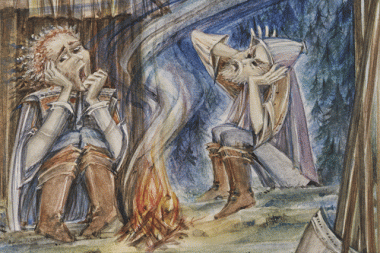
The knee pass spirit
Where the road between Pflach and Pinswang winds its way over the rocky spur of the Kniepass, there used to be a fortification, the "Lechschänzle". This fortification, located in front of the Ehrenberg fortress to ward off the first enemy attack, was last repaired in 1809 and is now in ruins.
The grinder worked like a man possessed. But what was ground there was not grain, but pure gold. Instead of flour, heaps of flashing gold coins appeared. With these the servant filled one sack after the other. With open mouth and shining eyes, the astonished miller counted the magnificent sacks - twenty-four were already filled to the top. The righteous man, however, was so horrified by this that he immediately chased the sinister servant away with all his devil's money.
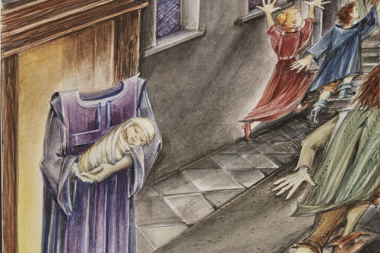
Ghost haunting to Pflach
Above the cottage mill near Pflach, on a hill on the way to the plague cemetery, stands the old little church of St. Ulrich. In this place it is said that it was not quite safe. In the chapel, it is said that on Sundays in the evening, after the prayer bell, a clergyman in full regalia but without a head came out of the sacristy carrying a "gift child" in his arms. Then the surprised worshippers ran out to the chapel in horror. One girl who witnessed this was so frightened that she lost her senses for the rest of her life.
Often a fiery ball was seen rolling down the hill from the church onto the street and disappearing in the rushing Archbach. At the time of Advent, one noticed bright little flames dancing in the tower. At the same time, mysterious music sounded from the inside of the lonely place of worship for sensitive ears that dared to come near.
Hüttenmühl-Liesl (Elisabeth Schöneich, who died around 1910 at the age of 82) had always felt compassion for the poor unsaved. When she could do nothing else in her old age, she often went up to the Ulrichskirchlein and prayed for the spirits. What she experienced there is not known; but the old woman became more and more whimsical and finally one said quite openly: "She is never quite right." But since then the spirits have disappeared.
Things were not quite right in the tower either. When the old cottage miller passed by at night with his cart, the horse bells always fell silent and the steeds began to shake and sweat. They would arrive at the mill exhausted and dripping with sweat. The old man also heard a miserable weeping and wailing from the chapel when he passed by here on his way home in the evening.


